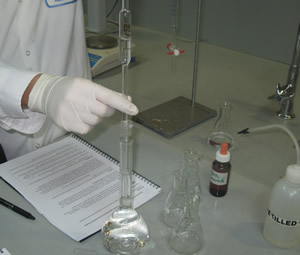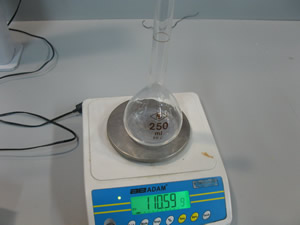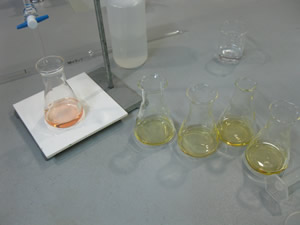Experiment 12—Analysis of the active ingredient in a household cleaner
Purpose
To determine the percentage by mass of ammonia in a household ammonia cleaner.
Duration 40 minutes
SAFETY
- Wear safety glasses and a laboratory coat for this experiment.
- Ammonia vapour irritates the skin, eyes and respiratory system. Dispense the household ammonia from a stock bottle in a well ventilated area or fume cupboard.
- Methyl orange may cause irritation to the skin and eyes. Avoid contact.
Materials
9 mL household ammonia, 100 mL standard hydrochloric acid (approximately 0.1 M), methyl orange indicator, 250 mL distilled water, 4 x 100 mL conical flasks, 250 mL volumetric flask, 10 mL measuring cylinder, small funnel, 20 mL pipette, pipette filler, dropping pipette, burette and stand, white tile wash bottle containing distilled water, electronic balance, safety glasses.
Theory
Ammonia is the main active ingredient in a number of household cleaning solutions. Ammonia ionises in water:
NH3(aq) + H2O(l) => NH4+(aq) + OH–(aq)
The solution formed is weakly basic and reacts with grease and oils. The cloudiness of household ammonia is due to the presence of soap, which is added by manufacturers to improve cleaning action. Manufacturers of household ammonias frequently claim an ammonia content of 5% by mass, but in practice, significant deviations from this value are often detected. Ammonia is very volatile and readily escapes from open containers as NH3(g).
Procedure
| 1 | Record the brand of household ammonia and the ammonia content specified by the manufacturer. |
|
2 |
Weigh a 250 mL volumetric flask and its stopper. Record the mass. |
|
3 |
Use a funnel to dispense about 8 mL of the household ammonia into the volumetric flask and firmly stopper the flask. Weigh the flask, stopper and ammonia solution. |
|
4 |
Add water to the volumetric flask and fill it to the 250 mL mark. Stopper the flask and invert several times so that the solution is thoroughly mixed. You may wish to use a small pipette to dispense the final drop of water in order to reach the mark more accurately. |
 |
5 |
Fill a burette with standard hydrochloric acid. Record the initial burette reading and the concentration of the acid. The burette should be read to 2 decimal places and has an error of +/- 0.05 mL. Note- the reading is taken from the bottom of hte meniscus. |
|
6 |
Pipette a 20.00 mL volume of the diluted ammonia solution into a 100 mL conical flask. Immediately replace the stopper on the standard flask. |
 |
7 |
Add two to three drops of methyl orange indicator to the solution in the 100 mL conical flask. Prepare three more conical flasks and carefully titrate with the hydrochloric acid until the endpoint is reached for each. |
|
8 |
Repeat the titration with fresh aliquots of the diluted ammonia solution until three concordant titres have been obtained—that is, until you obtain three titres where the smallest and the largest differ by no more than 0.1 mL. The video, on the right, shows the correct technique and permanent colour change. |
|
Results
|
TITRATION # |
||||
|
1 |
2 |
3 |
4 |
5 |
Final Reading (mL) |
|
|
|
|
|
Initial Reading (mL) |
|
|
|
|
|
Titre (mL) |
|
|
|
|
|
Questions and Calculations
- Calculate the average volume of the three concordant titres. Use this value to calculate the average amount of hydrochloric acid, in mol, added to each aliquot of diluted ammonia solution.
- Write balanced equations for the reaction which occurs between ammonia and hydrochloric acid. Use these equations to calculate the amount of ammonia that was present in each 20.00 mL aliquot.
- FULL EQUATION
- IONIC EQUATION
- Calculate the amount of ammonia present in the 250 mL volumetric flask. (This flask contained all of the ammonia present in the original sample.)
- Find the mass of the ammonia present in the original sample. Hence find the percentage by mass of ammonia in the original sample of the household cleaner.
General questions
- How does your percentage by mass of ammonia compare with the manufacturer's specifications?
- Give one reason why the result obtained by using a sample from an old, previously opened bottle of the cleaner might be lower than that obtained using a sample from a fresh bottle.
- Ammonia is a gas at room temperature but is extremely soluble in water. Draw the valence structure of an ammonia molecule and use your diagram to explain ammonia's high solubility.


